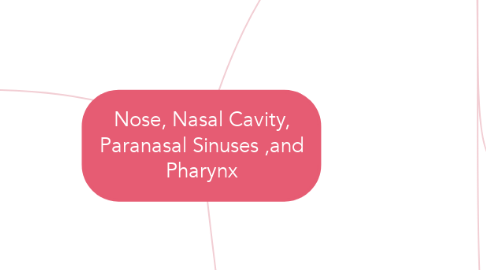
1. Nose
1.1. Definition: The external (anterior) nares or nostrils, leads to Nasal Cavity.
1.2. Formed above by: Bony skeleton.
1.3. Consist of
1.3.1. External Nose
1.3.2. Nasal Cavity
1.3.2.1. Extend from the external (anterior) nares to the posterior nares( choanae).
1.3.2.2. Divided into right and left halves by Nasal septum
1.3.2.2.1. each half include
1.4. Nerve Supply
1.4.1. Olfactory muscosa
1.4.1.1. Supplied by : Olfactory Nerves
1.4.2. Nerves of general sensation derived from
1.4.2.1. Ophthalmic
1.4.2.2. Maxillary Nerves
1.4.2.3. Autonomic fibers
1.5. Blood Supply
1.5.1. Arterial Supply
1.5.1.1. Maxillary
1.5.1.2. Facial
1.5.1.3. Ophthalmic
1.5.2. Venous Drainage
1.5.2.1. Facial
1.5.2.2. Ophthalmic
1.5.2.3. Spheno-palatine
1.5.3. Lymphatic Drainage
1.5.3.1. from vestibules
1.5.3.1.1. Drains into Submandibular Lymph node.
1.5.3.2. rest of Cavity
1.5.3.2.1. Drains into Upper deep Cervical Lymph node.
2. paranasal Sinuses
2.1. Air filled cavities located in the bones around the nasal cavity...
2.1.1. Ethmoid
2.1.2. Sphenoid
2.1.3. Frontal bones Maxillae
2.2. Lined by
2.2.1. Respiratory Mucosa which is continuos with the mucosa of the nasal cavity.
2.3. Drains into
2.3.1. Nasal Cavity
2.4. Functions?
2.4.1. Lighten the Skull
2.4.2. Act as resonant chambers for speech.
2.4.3. Air conditioning
2.4.3.1. The respiratory mucosal lining helps in warming, cleaning and moistening the incoming air.
2.5. Structures inside?
2.5.1. spheno-ethmoidal recess
2.5.1.1. sphenoidal sinus
2.5.2. Superior meatus
2.5.2.1. middle ethmoidal
2.5.2.2. maxillary
2.5.2.3. frontal and anterior ethmoidal sinu
2.5.3. inferior meatus
2.5.3.1. nasolacrimal duct
3. pharynx
3.1. Muscular tube lying behind the nose, Oral cavity and larynx.
3.2. Extend from the base of skull to level of 6th cervical vertebra, and continuous with esophagus.
3.3. The anterior wall is deficient and shows (from above downwards)
3.3.1. Posterior nasal apertures
3.3.2. opening of the oral cavity
3.3.3. Laryngeal inlet
3.4. The muscles are arranged into
3.4.1. 3 circular muscles(overlap each other)
3.4.1.1. Superior constrictor
3.4.1.2. Middle constrictor
3.4.1.3. Inferior constrictor
3.4.1.3.1. Special Function
3.4.1.4. Functions of all three muscles?
3.4.1.4.1. propel the bolus of food into the esophagus
3.4.2. longitudinal muscles
3.4.2.1. 3 muscles
3.4.2.1.1. Stylopharyngeus
3.4.2.1.2. Slapingopharyngeus
3.4.2.1.3. palatpharyngeous
3.4.2.1.4. Functions of all three muscles?
3.5. it is divided to three parts
3.5.1. Nasopharynx
3.5.1.1. extend from the base of skull to the soft palate
3.5.1.2. Communicate with the nasal cavity through( Posterior nasal apertures pharyngeal tonsils -Adenoides) present in the submucosa covering the roof.
3.5.1.3. Lateral wall shows
3.5.1.3.1. opening of auditory tube.
3.5.1.3.2. tubal elevation
3.5.1.3.3. tubal tonsil
3.5.1.3.4. pharyngeal recess
3.5.1.3.5. salphingopharyngeal fold
3.5.1.4. nerve supply
3.5.1.4.1. sensory
3.5.1.4.2. motor
3.5.2. Oropharynx
3.5.2.1. Lies behind the mouth
3.5.2.2. communicates with the oral cavity through (Oropharyngeal isthmus)
3.5.2.3. Extend from soft palate to upper border of epiglottis
3.5.2.4. Lateral wall shows
3.5.2.4.1. palatopharyngeal folds
3.5.2.4.2. palatoglossal folds
3.5.2.4.3. palatine tonsil
3.5.2.5. Arterial supply
3.5.2.5.1. Tonsillar artery from
3.5.2.6. Venous drainage
3.5.2.6.1. Join
3.5.2.7. Lymphatic drainsge
3.5.2.7.1. to the upper deep cervical (jugulodigastric node)
3.5.2.8. Nerve supply
3.5.2.8.1. Sensory
3.5.2.8.2. motor
3.5.3. Laryngopharynx
3.5.3.1. lies behind the laryngeal inlet and posterior surface of larynx
3.5.3.2. communicates with the larynx through the laryngeal inlet
3.5.3.3. extends from upper border of epiglottis to lower border of cricoid cartilage.
3.5.3.4. a small depression situated on either side of the laryngeal inlet is called " Piriform Fossa"
3.5.3.5. it is a common site for the lodging of foreign bodies.
3.5.3.6. branches of internal laryngeal and recurrent laryngeal nerves lie deep to the mucous membrane of the fossa and are vulnerable to injury during removal of a foreign body.
3.5.3.7. Nerve supply
3.5.3.7.1. Sensory
3.5.3.7.2. motor
3.5.3.8. Arterial supply
3.5.3.8.1. from branches of the following arteries
3.5.3.9. Veins Draining
3.5.3.9.1. drain into pharyngeal venous plexus
3.5.3.10. lymphatic drain
3.5.3.10.1. deep cervical lymph nodes either directly or indirectly by

